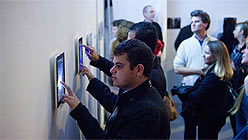On December 4, 2010, application developer Josh Michaels and photographer Hal Bergman staged a small coup in the form of a 24-hour pop-up show called Future/Canvas at the Box Factory in the Inner Mission of San Francisco. On the surface, the event looked like any other gallery opening: a lot of nicely (but not too nicely) dressed San Franciscans gathered in a white room with wine and a DJ and multiple projectors. And some art, of course, although this art trended towards swirling, multi-colored particles of glowing light that could be gathered with a pinch of your fingers across a touchscreen, or dispersed with a twirl. Yes, the first group iPad art show has come and gone, and the art community missed it.
Instead, we’ve been busy ignoring David Hockney, who has perhaps the first-ever, large-scale, solo iPhone/iPad show at Paris’s Pierre Berge-Yves St. Laurent Foundation, Fleurs fraîches (Fresh Flowers). Ostensibly, there’s good reason for this: the tension Hockney usually brings to banal subject matter through his markmaking isn’t present in his digital works, although I write this with an extreme caveat, because Fleurs fraîches includes so much projection, animation and interactivity that just looking at the images online is — both ironically and thankfully — a poor substitute for seeing the show.

Truthfully, much of the work displayed at Future/Canvas struggled with similar problems: fascinating technically, but not yet able to provide whatever that special tweak is that results in art with a capital A, a fact that Michaels and Bergman tacitly concede. They will be restaging the show for Apple’s World Wide Developer’s Conference in June and plan to use a more critical curatorial eye, although obviously one still oriented towards their market. “We just didn’t know how much was out there,” said Michaels.
Future/Canvas featured iPad works in multiple categories, from prints of illustrations made in Brushes and SketchBookPro to interactive applications like Magic Window, Typedrawing, and Uzu. While I enjoy Benjamin Rabe’s bunny drawings, using the iPad to simply produce and print drawings doesn’t seem to harness the unique abilities of the medium — more successful from an artist’s perspective is someone like Sandra Rauch, who uses the iPad to create her images but then repaints or silkscreens them (including the screen glare) in huge, tablet proportions. Walking up to a work like New York 4 creates an honest confusion as to what side of the screen you’re on.






